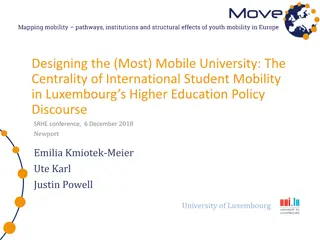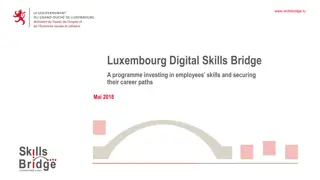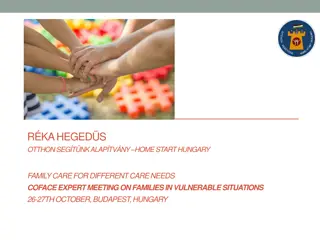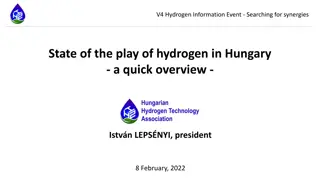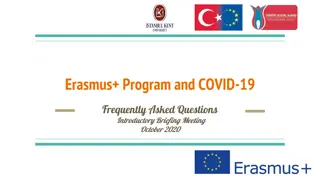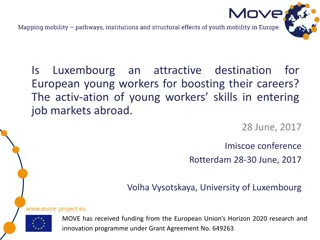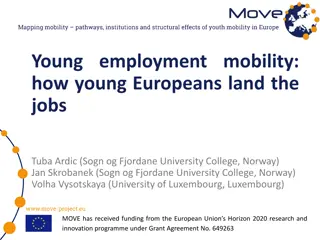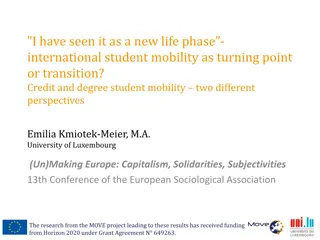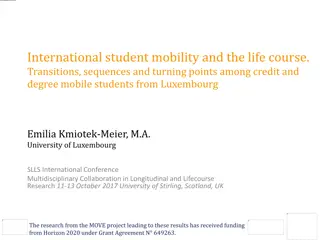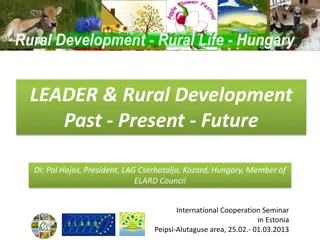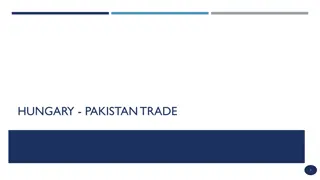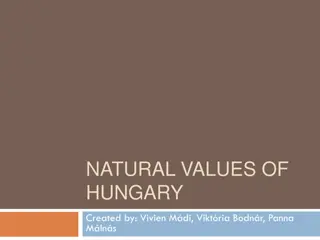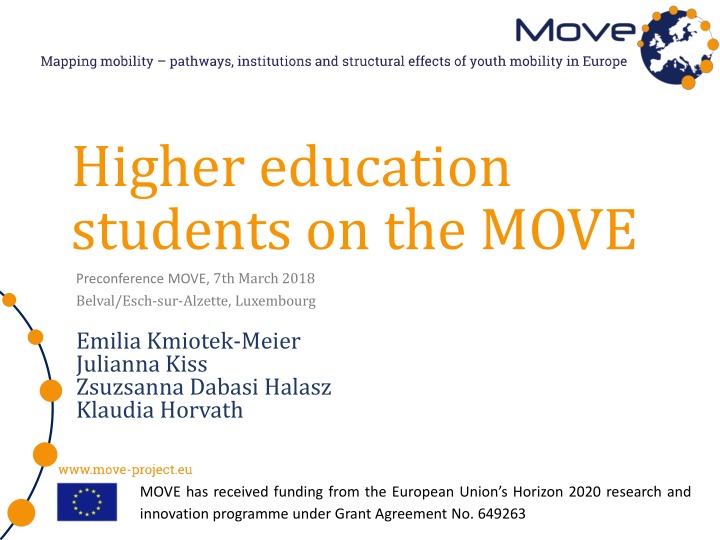
Student Mobility in Hungary and Luxembourg
This content explores student mobility trends in Hungary and Luxembourg, highlighting popular destination countries and insights from surveys and interviews. It delves into the background of student migration in the EU, discussing degree and credit mobility programs. The findings shed light on the educational landscape of these countries, emphasizing the importance of international study experiences for students.
Download Presentation

Please find below an Image/Link to download the presentation.
The content on the website is provided AS IS for your information and personal use only. It may not be sold, licensed, or shared on other websites without obtaining consent from the author. If you encounter any issues during the download, it is possible that the publisher has removed the file from their server.
You are allowed to download the files provided on this website for personal or commercial use, subject to the condition that they are used lawfully. All files are the property of their respective owners.
The content on the website is provided AS IS for your information and personal use only. It may not be sold, licensed, or shared on other websites without obtaining consent from the author.
E N D
Presentation Transcript
Higher education students on the MOVE Preconference MOVE, 7th March 2018 Belval/Esch-sur-Alzette, Luxembourg Emilia Kmiotek-Meier Julianna Kiss Zsuzsanna Dabasi Halasz Klaudia Horvath MOVE has received funding from the European Union s Horizon 2020 research and innovation programme under Grant Agreement No. 649263
Overview I. Student mobility in the Hungary and Luxembourg short introduction Survey findings for MOVE countries Findings from Interviews Summary / policy recommendations II. III. IV.
Student mobility (in the EU) student mobility degree mobility credit mobility part of programme abroad complete programme abroad Recent boom in migration/mobility studies In the EU more research on credit mobility (ERASMUS) some gaps -> personal perspective
Student mobility in Hungary Main destination countries for the Hungarian student: Austria, Germany, United Kingdom (2013: 1655, 1611, 1213 student base of UNESCO data). Popular destination countries too Holland, France. Most of the students come from Europe and Asia. The majority of Europeans are from Germany, Romania and Slovakia. 23.000 Number of students (thousand 21.000 19.000 17.000 person) 15.000 13.000 11.000 9.000 7.000 2003 2004 2005 2006 2007 2008 2009 2010 2011 2012 2013 2014 incoming mobility outgoing mobility Total inbound and outboundinternationally mobile students (in Hungary) Forr s: own work base of UNESCO data 5
Student mobility in Luxembourg 2003 foundation of the University of Luxembourg degree mobility from LU 75 % of all enrolled in tertiary education study abroad Degree mobility from LU: mainly DE, FR, BE degree mobility into LU + 50% of students enrolled have no LU nationality mainly other EU-countries credit mobility from LU an obligatory semester abroad for undergraduates 6
Programs Programs used in mobility 100% 90% 80% 70% 60% 50% 40% 30% 20% 10% 0% Erasmus None Others Mundus, Tempus, Alfa, Edulink, etc. Germany (N=348) Hungary (N=114) Luxembourg (N=439) Norway (N=155) Romania (N=278) Spain (N=670) All (N=2004) 10
Reasons (I) What reasons do you consider most important to spend some time/move abroad? % of yes 35% 30% 25% 20% 15% 10% 5% 0% To learn/improve languages In order to improve opportunities for personal/professional development Studies related reasons Germany (N=981) Hungary (N=334) Luxembourg (N=1221) Norway (N=436) Romania (N=816) Spain (N=1987) All (N=5775) 11
Reasons (II) What reasons do you consider most important to spend some time/move abroad? % of yes 18% 16% 14% 12% 10% 8% 6% 4% 2% 0% Feeling attracted to the culture /country Previous knowledge of the language To improve working conditions Germany (N=981) Hungary (N=334) Luxembourg (N=1221) Norway (N=436) Romania (N=816) Spain (N=1987) All (N=5775) 12
Financing (I) How did you finance your stay? Mean (1= non-existent; 5=very important) 5 4.5 4 3.5 3 2.5 2 1.5 1 0.5 0 Family assistance European mobility programmes Private funds/savings National study grants Germany (N=337, 302, 342, 307) Hungary (N=113, 111, 114, 108) Luxembourg (N=394, 427, 431, 371) Norway (N=142, 148, 143, 118) Romania (N=274, 253, 275, 240) Spain (N=655, 623, 666, 530) All (N=1915, 1864, 1971, 1674) 13
Financing (II) How did you finance your stay? Mean (1= non-existent; 5=very important) 4 3.5 3 2.5 2 1.5 1 0.5 0 Loan Working full time or part time Other grants and awards Business programmes/funded by employer Germany (N=338, 312, 319, 307) Hungary (N=111, 110, 110, 111) Luxembourg (N=398, 378, 384, 398) Norway (N=149, 120, 132, 141) Romania (N=265, 243, 244, 242) Spain (N=637, 571, 548, 532) All (N=1898, 1734, 1737, 1731) 14
Obstacles (I) Main obstacles; % of yes 25% 20% 15% 10% 5% 0% Lack of financial resources to move abroad Germany (N=616) Lack of sufficient language skills Luxembourg (N=688) Lack of support or information Spain (N=1417) Hungary (N=215) Norway (N=286) Romania (N=563) All (N=3785) 15
Obstacles (II) Main obstacles; % of yes 30% 25% 20% 15% 10% 5% 0% I did not experience any barrier or difficulty Psychological well-being Obstacles or differences in recognition of qualifications Germany (N=616) Hungary (N=215) Luxembourg (N=688) Norway (N=286) Romania (N=563) Spain (N=1417) All (N=3785) 16
Peers Peers can influence decisions on mobility: impact of students with mobility background on potential students (but also wish to stay home) Collective mobility: common decision as it is easier to travel and to stay abroad together Communication with international students/co-nationals is more frequent, than with native students, (similar experiences, institutional organisation; life in the bubble) Support function (substitute to family) Source of information / network Face-to-face and virtual peers 18
Process Process Towards Mobility Languages: to learn / to improve / is easy English programmes (rather Hungary) Conscious/planned mobility: process Eagerness to go Obligation to go abroad / only way to study Social norm (country / class) distinction Think twice to go professional life afterward Academic aspects (seldom, rather degree) 19
Funding, Money, Paperwork, Bureaucracy Paperwork at universities (lengthy process) Strong bureaucracy in some countries Lack of information; lack of contact with host/home institution Getting lost (and found!) in the new system High costs / uneven funding Transfer of Erasmus scholarship (time) Credit recognition Money and autonomy (to spend money alone) 20
Youth parctices Wish for international environment popular to go abroad Social media Life experience (against all odds) Personal development Freedom / autonomy (parents) Learn to adapt: to the new environment, other culture, quality of the accommodation, etc. Transition 21
IV Summary 22
Policy recommendation (I) Structure a well-developed institutional support structure: Student mobility within Europe mostly short-term character (one or two semesters abroad) enough and competent staff providing information reasonable timeframe, both at sending and receiving institutions preestablished / transparent procedures Inclusion / integration increase numbers of scholarships adjust mobility scholarship (Erasmus+) in particular, for students coming from less wealthy countries reconsider country groups in regard to the amount of scholarship provided 23
Policy recommendation (II) Language skills better integration of foreign students at the hosting institutions more vivid exchange with native students, Do not forget about foreign degree students different support than native regular students / or credit studnets Enable easy and swift recognition of foreign European (EHEA) diploma and credits (ECTS) in other European countries. -> are all obstacles really bad? (learn aspect) 24
Thank you for your attention! Zsuzsanna Dabasi Halasz Julianna Kiss Klaudia Horv th Horvath.klaudia@uni-miskolc.hu Contact: Emilia Kmiotek-Meier emilia.kmiotek@uni.lu University of Luxembourg Facult des Lettres, des Sciences Humaines, des Arts et des Sciences de l'Education University of Miskolc Faculty of Economics Institute of Geography and Spatial Planning Institute of World and Regional Economics http://www.move-project.eu The research from the MOVE project leading to these results has received funding from Horizon 2020 under Grant Agreement N 649263. 25


